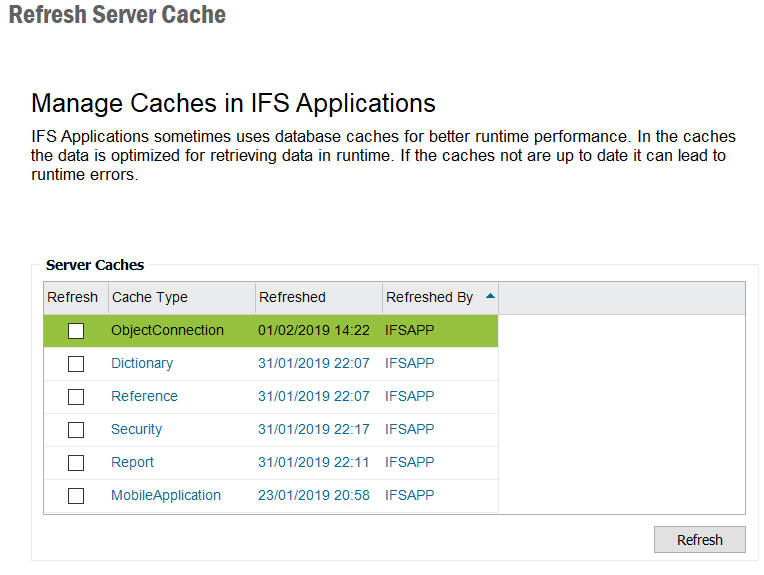
IFS Applications sometimes use database caches for better runtime performance. In the caches the data is optimized for retrieving data in runtime. If the caches are not up to date it can lead to runtime errors.
Cache Types:
Refresh Server Cache feature is used to refresh/rebuild the caches in the server. This window is found in Solution Manager folder.

You can refresh different caches by selecting the corresponding cache type in the Refresh Server Cache feature. Select the relevant cache types in Refresh Column and click the Refresh button to build your caches.
Click on the corresponding Refresh Cache link to refresh language caches, each link will navigate you to a corresponding feature. (Use the Refresh Language Cache option in each feature to refresh language cache).
The Dictionary cache should be refreshed after you have deployed any view or package into the database. The Dictionary cache is used to get information about Logical Units (LUís), attributes, methods, arguments and IIDís.
Note:This will run a Full Database cache refresh. Therefore it is recommended to do a refresh only on proper maintenance window where all the transactions on the system are stopped.
The Reference cache should be refreshed after you have deployed any view (package) which changes the reference information about the LU's. The Reference cache manages data needed for checking of referential integrity. The Reference cache is used any time you remove data in any client.
Note: The Dictionary cache must be up to date when running this cache.
The Security cache should be refreshed after you have created or removed any user/permission set or granted or revoked a permission set to any user/permission set. The Security cache is used to build the client navigator and to check whether you have the right to execute any view or method. When granting a permission set to a user or granting a permission set to another permission set using Solution Manager the security cache is automatically refreshed. When modifying a permission set the effect is immediate on the server side. IFS Enterprise Explorer will not be aware of these changes until the Security Cache is refreshed and the user has logged off and logs on again.
Note: The Dictionary cache must be up to date when running this cache.
The Object Connection cache should be refreshed when you have done changes to object connections. The Object Connection cache holds Meta data about object connections. The Object Connection cache collects more Meta data about the object connections when it is refreshed.
The Report Cache should be refreshed after you have added/modified a report or any resource connected to a report (e.g. report layout, columns in a report). The Report cache holds Meta data about reports. During the refresh the data for each report is refined so that the performance during runtime is improved. The Report cache holds information about report title, prompts for attributes, layouts, format and life span.
The Mobile Application Cache should be refreshed when changes are made to the Grouped Push Synchronization Process as documented in Mobile Framework Synchronization Guide.
Note: It is not necessary to schedule a task to refresh these caches, only refresh these caches when needed